While self-checkouts improve operational efficiency in the hospitality industry, a Cashier's personal interaction adds a friendly, human touch to the customer experience.
If you’re looking to hire a Cashier for your restaurant or hotel, here’s a five-step guide to help you find one who’ll help make your business stand out.
How To Hire a Cashier in 5 Steps
Hiring a reliable cashier is key to keeping your front-of-house operations smooth and customer-friendly. From posting the right job ad to asking the right interview questions, here’s how to find the best fit for your team.
Step 1: Identify the Type of Cashier You Need
Do you need a part-time or a full-time Cashier? Are you looking for someone to manage a team or someone to focus solely on the duties?
Being clear about these details will help you create a candidate profile that aligns with your business needs and ensures you find the right fit.
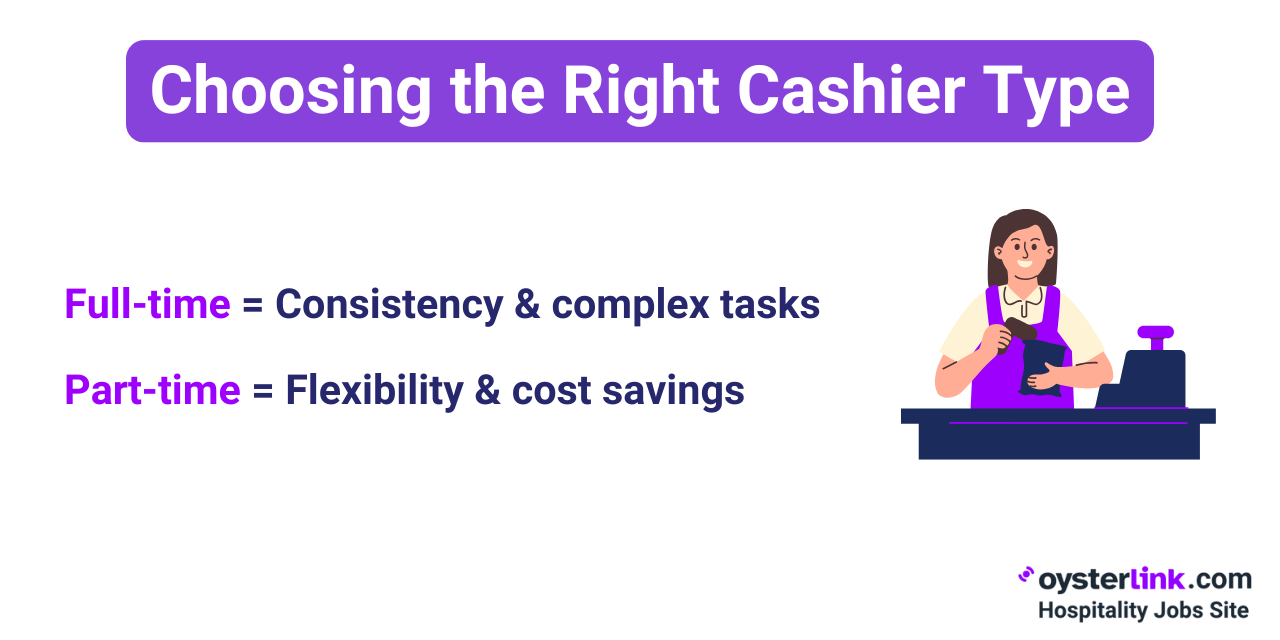
Work arrangement
Your budget plays a significant role in determining whether you need a part-time or a full-time employee. Hiring full-time staff means you have the resources to offer benefits and pay for 40 hours of work each week.
Customer traffic is another key factor. For example, if you're managing a high-traffic restaurant, a full-time Cashier may be necessary to maintain the level of service needed during busy hours.
Additionally, the complexity of the tasks involved should be considered when deciding between a part-time or a full-time role.
For instance, in a luxury retail setting, you may prefer a full-time Cashier who can consistently provide personalized services, such as styling advice or detailed product explanations.
While part-time employees with a passion for luxury goods can learn these details, full-time staff are often better equipped to handle complex customer needs and provide the consistent service your business requires.
Type of establishment
While the key responsibilities of a Cashier remain the same regardless of the establishment, it’s important to specify where they’ll work, as this often entails additional duties tied to the environment.
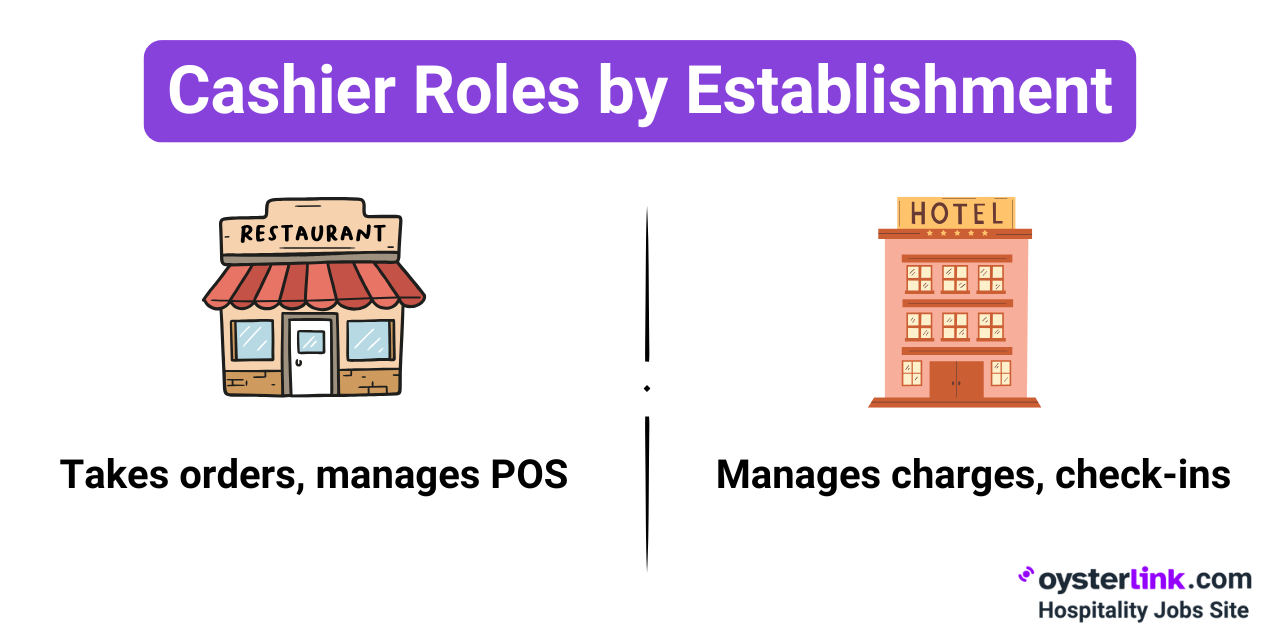
For example, a Restaurant Cashier handles more than just transactions. They take orders from Servers or directly from customers, input them into the POS system and ensure any special requests are communicated to the kitchen.
In contrast, Hotel Cashiers focus more on room charges, handling customer complaints and checking guests in and out.
Unlike Restaurant Cashiers, Hotel Cashiers don’t take food or drink orders but ensure guest bills are accurate and processed efficiently.
Types of Cashiers
Cashiers can be classified according to their workplace and level of seniority. Below, we’ve listed six basic types of Cashiers and identified each of their key duties.
| Cashier Type | Typical Duties |
| Entry‑Level Cashier |
|
| Grocery Cashier |
|
| Retail Cashier |
|
| Ticketing Cashier |
|
| Gas Station Cashier |
|
| Head Cashier |
|
Understanding the duties of the role helps create a clear job description that attracts candidates with the right skills.
For example, a Retail Cashier needs strong upselling skills and product knowledge, while a Grocery Store Cashier must possess accuracy in processing high-volume transactions and proficiency in handling various payment methods.
Step 2: Create an Attractive Cashier Job Description
Once you know the type of Cashier you need, the next step is writing a clear, appealing job description. A strong description helps attract qualified candidates and ensures expectations are well-defined from the start.
If you’re unsure how to structure or maintain job descriptions, watch Julie Kniseley’s expert video on why well-written listings matter for recruitment, pay alignment and compliance with FLSA and ADA standards.
To make your listing stand out, consider adding:
- Flexible scheduling
- Performance bonuses
- Discounts or free services
- Additional paid time off
- Health insurance
These benefits enhance employee satisfaction, loyalty and productivity. If you can’t afford to offer comprehensive benefits or a salary above the market rate, focus on building a supportive company culture that values contributions and respects employees.
Research shows that companies with strong, positive work cultures enjoy four times the revenue growth.
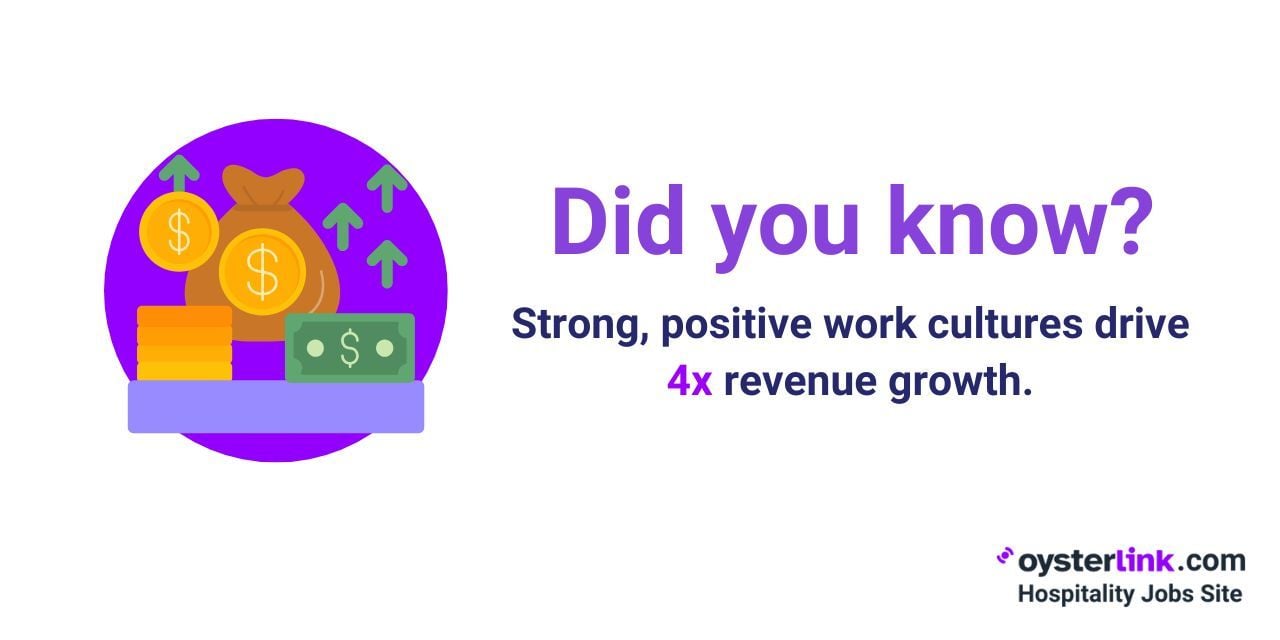
When employees feel appreciated, they’re more engaged, motivated and likely to remain loyal to your company, ultimately reducing turnover rates.
Step 3: Know the Top Places To Source the Best Cashiers
Advertising your job opening across multiple platforms maximizes your reach, improves applicant diversity and boosts your employer branding.
Below are some places where you can post your job ad.
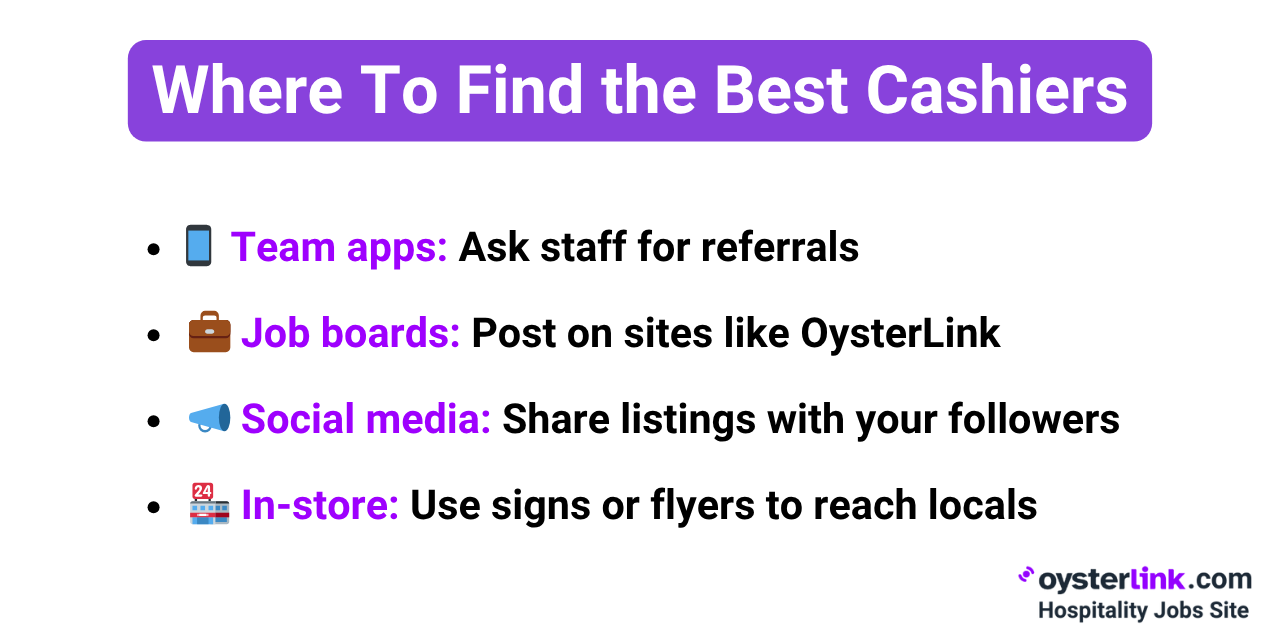
Team communication app
Use your team communication app to share your job description and see if any of your staff would like to recommend someone for the role. Offering an incentive for successful referrals encourages employee engagement and taps into your team's existing network.
Job boards
Create a hospitality job post on industry-specific platforms like OysterLink. OysterLink gives you access to more than 400,000 hospitality and restaurant job seekers. Its intuitive design and user-friendly features allow you to post multiple job openings within minutes.
It also offers FREE job description templates you can customize for 35+ positions to expedite your recruitment process.
Social media
Posting on your social media pages is an excellent way to engage with your community, showcase your business culture and tap into your followers’ networks for potential candidates. When posting a job on social media, make sure to pair it with an eye-catching image or graphic to increase engagement.
Inside your store
Posting a hiring sign inside your store, handing out flyers or displaying your job opening on a bulletin board is a powerful, yet often overlooked, way to advertise openings. These traditional, physical methods of recruitment serve as an effective complement to your online job postings and can help you reach candidates who may not be active on online platforms.
Step 4: Screen and Interview Your Cashier Candidates
Once you’ve gathered enough applicants from your job posting, start screening them either manually or through an Applicant Tracking System to keep only those who meet the minimum qualifications for the position.
If needed, you can also conduct a brief phone screening to clarify any important details before moving forward, such as their availability or work schedule preferences.
After the screening process, you can now schedule an interview with candidates who appear to be a good fit. The interview is your opportunity to assess not only their technical skills but also their soft skills, such as communication, problem-solving and their ability to handle customer interactions.
You can ask behavioral and situational questions to understand how they’d respond to real-world challenges, like handling an unhappy customer or managing busy periods during peak hours.
Make sure to ask the same questions to all your candidates to ensure a fair assessment of skills, qualifications and cultural fit.
Step 5: Plan a Proper Onboarding
According to Gallup’s latest report, only 12% of new hires said their company offered a good onboarding experience.
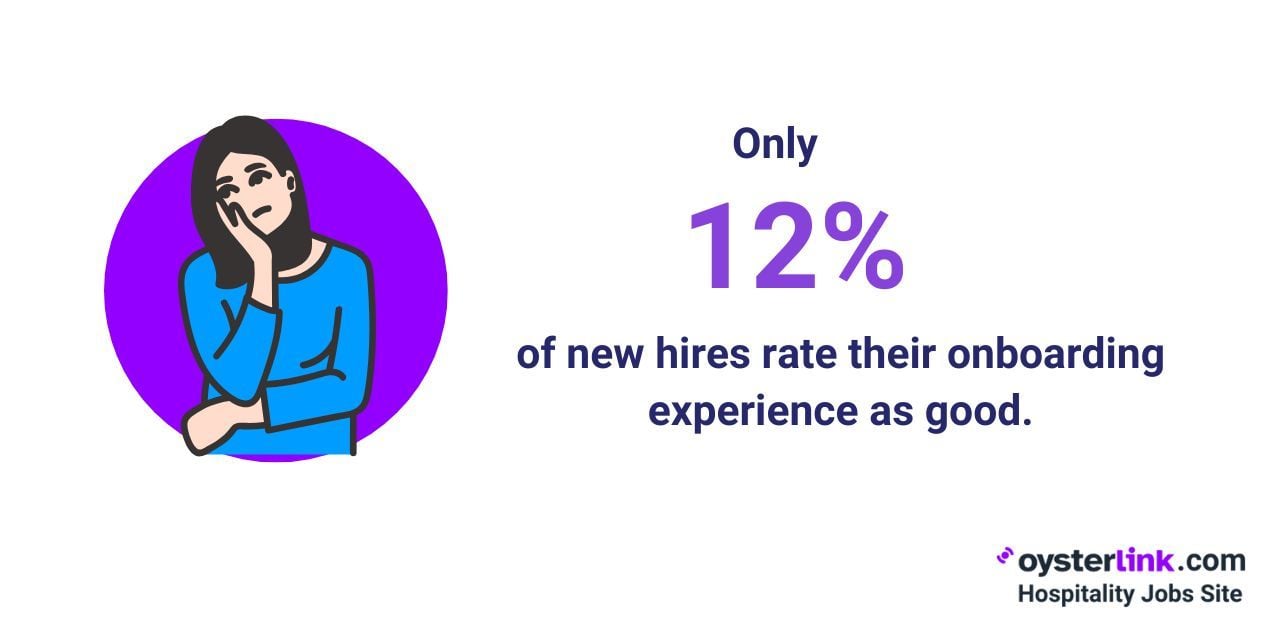
With that said, make sure you’re ready to conduct an onboarding session as soon as you’ve identified the best candidate. This can include a brief introduction to your company’s core values. Since Cashiers directly interact with customers, they need to understand the company’s brand and customer service standards.
Once the general onboarding is done, you can now do role-specific training which can include how to operate the POS system, process transactions and issue receipts.
Finally, set clear expectations and goals by sharing the key performance indicators you’ll be measuring their performance against. This helps employees know what they need to succeed in their roles.
More Tips on How To Hire a Cashier
Below are more tips to help you find your ideal candidate.
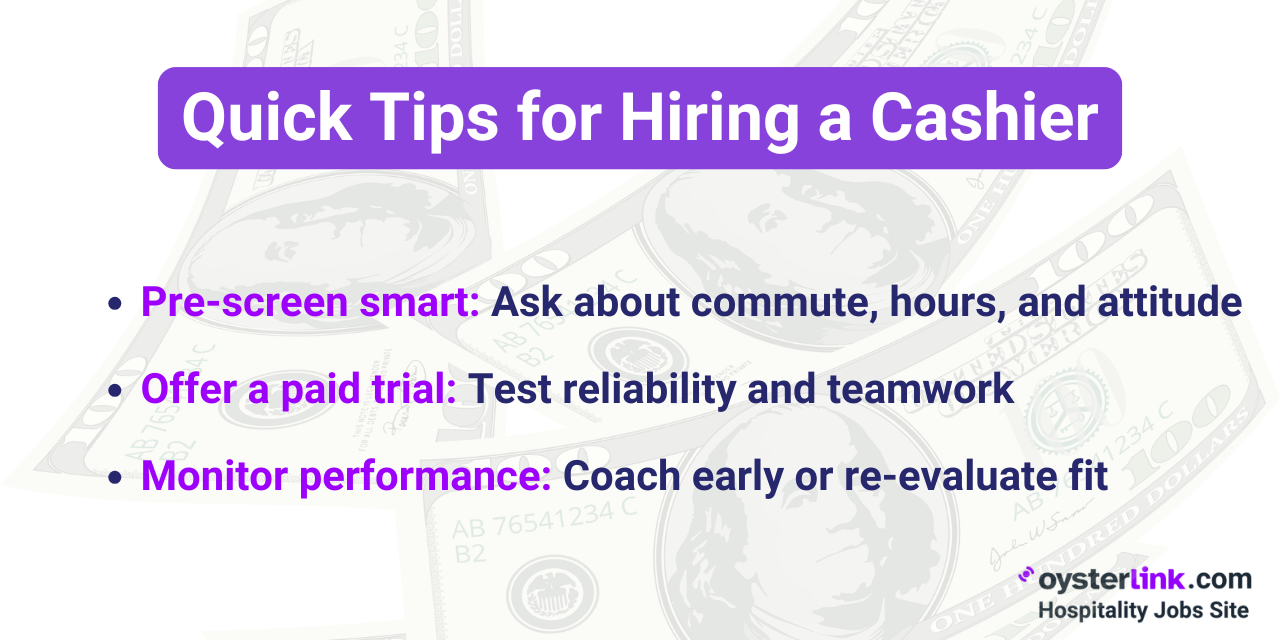
Pre-screen applicants through a series of questions
Since this is an entry-level position with, more often than not, no prior experience required, you’ll likely receive many applications.
You can immediately sift through unqualified candidates to reduce the work involved in screening resumes by asking questions about their ability to commute, availability for your working schedule and fit for your work environment. Below are sample questions that you can ask:
- Can you commute easily to the restaurant?
- Are you available to work varying hours based on business needs?
- Do you enjoy repetitive tasks like scanning items and handling transactions?
- How do you feel about being the face of the company?
- How do you handle situations when you’re asked about a product or promotion you’re not familiar with?
Do a paid trial run
Although not necessarily a common part of the hiring process, a trial run can help determine if the candidate is the right fit without a long-term commitment.
After the interview, select two to three candidates who have passed the background check and invite them to do a trial run for a week. This will let you see if they demonstrate the necessary skills, show reliability and punctuality and blend well with the team.
Monitor performance
During the paid trial run or even once you’ve selected an applicant, make sure to monitor their performance. If they’re not meeting your standards, you can address this early by offering additional training or support.
But if performance still doesn’t improve after mentorship, you may need to let them go rather than prolong the situation. As a Hiring Manager, your goal is to build a competitive and productive team, not to let underperformance hold others back and cause unnecessary stress.
Hiring a Cashier Who Fits Your Team Culture
When you hire a cashier whose values align with your workplace, you foster stronger teamwork, consistency, and retention.
In the U.S., retail turnover can exceed 60%, often because employees don’t feel a cultural connection.
Give priority to candidates whose work style, attitude and goals match your brand.
Use scenario-based questions to assess how they’d handle real customer interactions. Investing in culture fit early helps reduce costly early-stage turnover.
Avoid These Mistakes When Hiring a Cashier
Many hiring failures stem from unclear job expectations, rushed screening, or overlooking soft skills.
Around 46% of new hires fail within 18 months due to mismatches in role clarity.
To avoid this, ensure the job description clearly defines responsibilities and success metrics.
Don’t skip structured interviews and reference checks. Training hiring managers to identify red flags can prevent costly mis-hires.
More Resources on Cashier Hiring and Careers
Whether you’re an employer looking to hire qualified cashiers or a candidate exploring new opportunities, these trusted resources provide reliable data, insights and tools to support every step of the hiring and career journey.
- U.S. Bureau of Labor Statistics (BLS): Cashiers Occupational Outlook, wage data and employment trends
- American Staffing Association (ASA): Workforce research, staffing trends and compensation insights
- OysterLink – Cashier Career Guide: Detailed overview of Cashier roles, skills and pay expectations
- OysterLink – Pros and Cons of Being a Cashier: Insight into the realities of working as a Cashier
- OysterLink – Post a Job: Hire top Cashiers and hospitality professionals quickly and efficiently
How To Hire a Cashier: Final Thoughts
Cashiers play a vital role in shaping the customer experience by combining speed, accuracy and friendliness at the front line.
Whether you’re hiring for a hotel, restaurant or retail space, clearly defining the role, using the right sourcing strategies and providing strong onboarding are key to finding a dependable Cashier who fits your business.
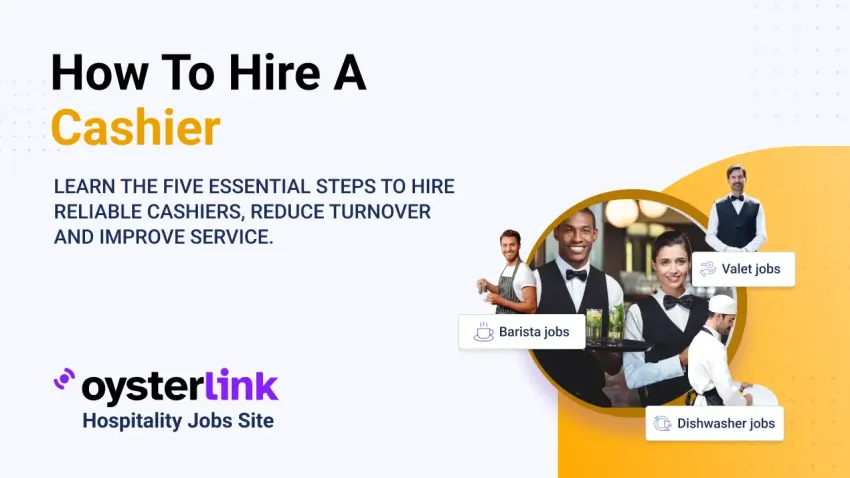







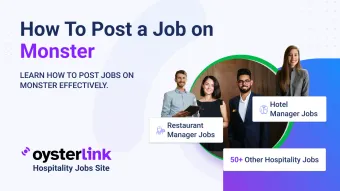
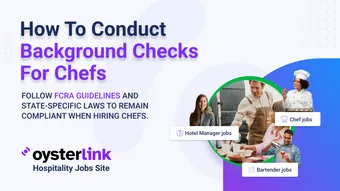


Loading comments...